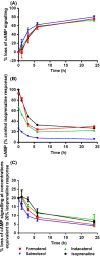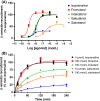Functional desensitization of the β 2 adrenoceptor is not dependent on agonist efficacy
- PMID: 25692019
- PMCID: PMC4317232
- DOI: 10.1002/prp2.101
Functional desensitization of the β 2 adrenoceptor is not dependent on agonist efficacy
Abstract
Chronic treatment with β 2 adrenoceptor agonists is recommended as a first-line maintenance therapy for chronic obstructive pulmonary disease (COPD). However, a potential consequence of long-term treatment may be the loss of functional response (tachyphylaxis) over time. In this study, we have investigated the tendency of such agonists, with a range of efficacies, to develop functional desensitization to cAMP responses in primary human bronchial smooth muscle cells following prolonged agonist exposure. The data show that upon repeat exposure, all agonists produced functional desensitization to the same degree and rate. In addition, β 2 adrenoceptor internalization and β-arrestin-2 recruitment were monitored using β 2·eGFP visualization and the PathHunter™ β-arrestin-2 assay, respectively. All agonists were capable of causing robust receptor internalization and β-arrestin-2 recruitment, the rate of which was influenced by agonist efficacy, as measured in those assays. In summary, although a relationship exists between agonist efficacy and the rate of both receptor internalization and β-arrestin-2 recruitment, there is no correlation between agonist efficacy and the rate or extent of functional desensitization.
Keywords: COPD; agonist efficacy; functional desensitization; β2 adrenoceptor.
Figures






References
-
- Aziz I, Tan KS, Hall IP, Devlin MM, Lipworth BJ. Subsensitivity to bronchoprotection against adenosine monophosphate challenge following regular once-daily formoterol. Eur Respir J. 1998;12:580–584. - PubMed
-
- Bhagat R, Kalra S, Swystun VA, Cockroft DW. Rapid onset of tolerance to the bronchoprotective effect of salmeterol. Chest. 1995;108:1235–1239. - PubMed
-
- Calebiro D, Nikolaev VO, Persani L, Lohse MJ. Signaling by internalized G-protein-coupled receptors. Trends Pharmacol Sci. 2010;31:221–228. - PubMed
-
- Carter AA, Hill SJ. Characterization of isoprenaline- and salmeterol-stimulated interactions between beta 2-adrenoceptors and beta-arrestin 2 using beta-galactosidase complementation in C2C12 cells. J Pharmacol Exp Ther. 2005;315:839–848. - PubMed
-
- Chapman KR, Rennard SI, Dogra A, Owen R, Lassen C, Kramer B, et al. Long-term safety and efficacy of indacaterol, a long-acting β2-agonist, in subjects with COPD: a randomized, placebo-controlled study. Chest. 2011;140:68–75. - PubMed
LinkOut - more resources
Full Text Sources
Other Literature Sources

